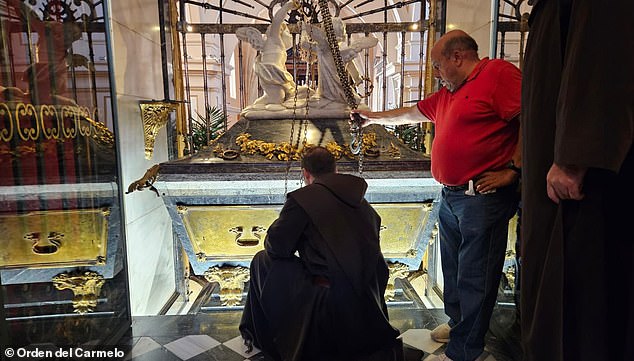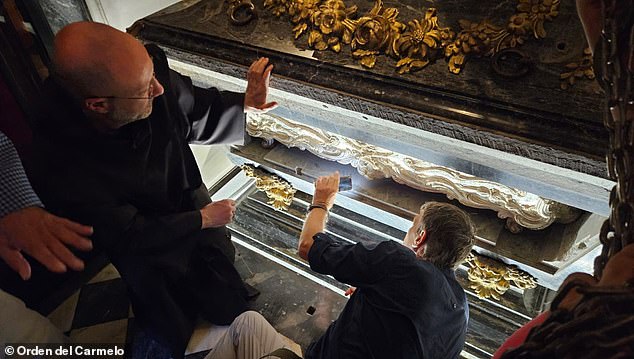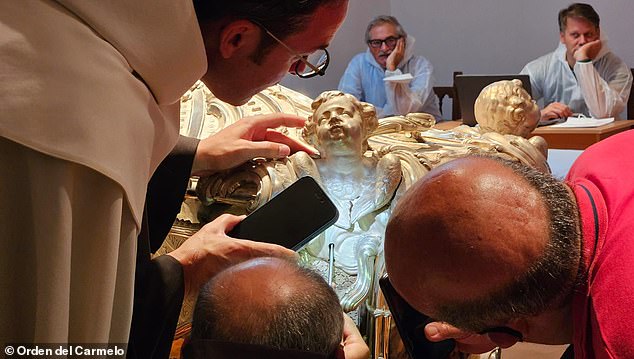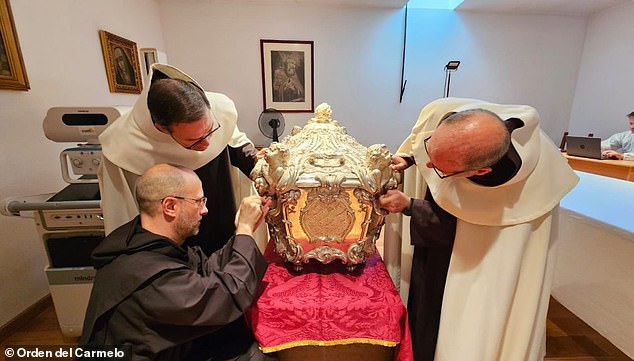Perfectly preserved body of Saint Teresa, who died 450 years ago, is considered a ‘miracle’
A perfectly preserved saint who died nearly 500 years ago is being hailed as one of ‘God’s miracles’.
Saint Teresa of Avila, who died in 1582, was exhumed from a church in Spain last month, leaving experts stunned that she had not decayed.
The team compared photographs of the remains taken in 1914 with those of her today. They concluded that her face was still “clearly visible” and that the remains showed “vermin.”
The silver casket, encased in marble, was opened to study the remains of Saint Teresa and gain insight into the health problems she faced during her life.
The Diocese of Avila in Spain has opened up the tomb of a medieval saint to conduct an analysis of the 450-year-old remains. Pictured: The silver marble coffin of Saint Teresa of Avila

Saint Teresa of Avila, who died in 1582, is the patron saint of chess players, lace makers, people who have lost their parents, people in need of mercy, people in religious orders, people ridiculed for their piety, and the sick.
The body of Saint Teresa was exhumed on August 28 by Marco Chiesa, the Postulator General of the Order, in the Diocese of Avila in Spain.
Church officials shared the news on social media, where Catholics said: “Her body is still intact. Search for God’s miracles.’
When the tomb was opened, a team of doctors compared photographs taken in 1914 of St. Theresa’s face and feet. The postulator said it was “difficult to make a comparison” because the images are in black and white.
No images of the saint from 1914 or last month have been released yet, but they said they plan to share them eventually.
Chiesa explained that “there is no color, there is no skin color, because the skin is mummified, but it is visible, especially in the center of the face. It is very visible. The expert doctors can see Teresa’s face almost clearly.”
Saint Theresa is the patron saint of chess players, lace makers, deceased parents, people in need of mercy, people in religious orders, people ridiculed for their piety, and the sick.
She was a Spanish nun and in 1970 became the first woman to be elevated to Doctor of the Church. This honor is given to deceased saints for their significant contribution to Church teaching.
Saint Theresa was canonized in March 1622.

10 keys are needed to reach the coffin of Saint Teresa to protect her remains from unauthorized access. Pictured: The silver marble coffin of Saint Teresa of Avila

The remains of Saint Teresa were moved to a sealed space where experts can analyze her DNA and understand how to better preserve relics in the future. Pictured: The silver marble coffin of Saint Teresa of Avila
Since her body was last exhumed, it has been described as “undecayed,” meaning it has not undergone the normal decomposition process after death.
Researchers are keen to find out why the body of St. Theresa has not yet decomposed. They hope this will provide insight into how we can preserve relics in the future.
Chiesa confirmed that they are still in the early stages of analyzing the body of Saint Teresa, adding that it is too early to release details of their additional examinations.
The diocese has taken strict measures to protect the saint’s remains, including requiring a total of 10 keys to access her coffin.
Three of the keys are in the possession of the Duke of Alba, another three are in the possession of the city of Alba de Tormes, and the Discalced Carmelite, Father General in Rome, has another three in his possession.
The 10th key, also known as the King’s Key, is also needed to access Teresa’s remains. To open the outer gate, three keys are needed, to open the tomb, three are needed, and to open the coffin, four are needed.

The team has not released any photos of St. Therese’s remains, stating only that she has not changed since her body was last exhumed in 1914. Pictured: The silver marble casket of St. Therese of Avila

It is expected to take several months before doctors and scientists receive the results of their analysis from a laboratory in Italy. Pictured: The silver marble coffin of Saint Teresa of Avila
Her remains were transferred to a sealed room, where a team of doctors and scientists will perform visual examinations and take photographs and X-rays of her remains.
The samples will be sent to a laboratory in Italy and it is expected to take several months before the data can be collected and released to the public.
“The Order considers it desirable to do this work and it will be the specialists who, after their thorough work, will give us conclusions,” Chiesa said.
‘We know from similar studies that in the future we will be able to collect very interesting data about Teresa and make recommendations for the conservation of the relics, but that will take some time.’
While studying her body, experts also discovered a health problem on her feet, namely calcareous spikes, which would indicate her religious beliefs.
Calcareous spines are sharp bones that resemble the endoskeletons of starfish and sea urchins.
Saint Theresa also suffered from convulsions, stomach problems, dizziness and loss of consciousness.
She defended her mystical experiences in her memoirs, linking her symptoms to a connection with God.
“We know that she had difficulty walking in recent years, with the pains that she describes,” Chiesa explains. “Sometimes, when you look at a body, you discover more than the person had.”
‘When analyzing the foot in Rome, we saw the presence of calcareous thorns that make it almost impossible to walk. But she walked (to) Alba de Tormes and then died.’
In 1582, when Saint Theresa was about 67 years old and ill, she left for Alba de Tormes to visit an old friend together with Anne of Saint Bartholomew.
Chiesa said that despite her condition, Saint Teresa “had the desire to continue and move forward, despite her physical disabilities.”
On the way she became exhausted and seriously ill. Three days after Saint Theresa and her companion arrived at the local monastery, she said to Anna: ‘At last, my daughter, I have reached the house of death.’
The coffin of Saint Teresa was last opened in 1914, after Father Clemente de los Santos, then Superior General of the Discalced Carmelites, said he wanted to see the bodies of the founding saints during his visit to Spain.
The diocese of Ávila declared at the time that the body was still “completely incorrupt,” just as it had been when it was first opened in 1750.
